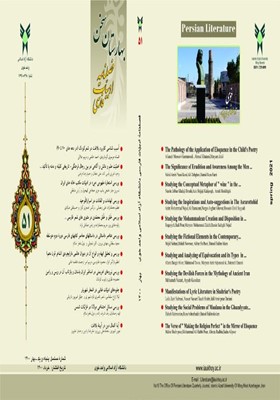بررسی نیروهای اهریمنی در اساطیر ایران باستان و بازتاب آن در ویس و رامین
محورهای موضوعی : فصلنامه بهارستان سخنمعصومه نظری 1 * , ایوب کوشان 2
1 - دکتری گروه زبان و ادبیّات فارسی و مدرّس مؤسسه غیر انتفاعی سراج تبریز، ایران.
2 - گروه زبان و ادبیّات فارسی، واحد تبریز، دانشگاه آزاد اسلامی، تبریز، ایران.
کلید واژه: اوستا, اهریمن, پری, دیو, ویس و رامین, کلید واژهها: آیین زرتشت,
چکیده مقاله :
چکیده باور به دوگانگی و تقابل نیروهای خیر و شرّ در طبیعت، در وجود انسان و در نیروهای متعارض موجود در جهان را تقریباً در اساطیر تمام اقوام از جمله اقوام هند و اروپایی و آریایی کهن، میتوان دید. در آیین زردشت، اهورامزدا در رأس نیروهای خیر و نیکی، و اهریمن در رأس تمام نیروهای بدی قرار دارد. باور به این دوگانگی در آثار حماسی- اساطیری، نشانگر باور انسان اساطیری بر تقسیم جهان به دو عرصۀ نیک و بد است. در این پژوهش سعی شده است تا نیروهای اهریمنی در اساطیر ایران باستان و بازتاب آن در ویس و رامین مورد بررسی قرار گیرد و به این سؤال پاسخ داده شود که آیا این موجودات نشانی از موجودات اهریمنی مطرح در اوستا دارند و آیا خویشکاری اسطورهای خود را حفظ کردهاند؟ روش کار، توصیفی- تحلیلی است. از نتایج به دست آمده میتوان گفت که موجودات اهریمنی در ویس و رامین با دیوان سترگ موجود در اوستا و متون پهلوی قابل تطبیق است و گاه موجوداتی واقعی هستند که با تصویری عینی و آشکار در دنیای اساطیری تواناییهای فرا طبیعی دارند. در این داستان علاوه بر وجود دیوان مطرح در فرهنگ ایران باستان دربارۀ دو دیوِ مهر و تباهی نیز سخن رفته است.
Abstract Belief in dualism and the opposition of goodness and badness can be seen in the nature, human being and the contrasting forces in the world and in the mythology of ethnics including Indo-European and Aryan tribes. In Zoroastrianism, Ahura Mazda is the omnipotent of goodness , and Ahriman ( devil ) stands at the top of satanic forces.Belief in this dualism, in the mythological and epic works indicates the tenet of mythological man in the division of the world into two areas of goodness and badness. It has been tried, in this paper, to study the satanic forces in the ancient mythology of Iran and its reflection in " The Wayce and Ramin " and answer the question whether these creatures have the signs of satanic manner in the Avesta or not, and have they maintained their self-innovence. The study method is descriptive-analytic. One can conclude from the results that satanic creatures in the wayce and Ramin are adaptable with giant demons in the Avesta and Pahlavi texts; sometimes they are real beings which, with concrete picture are able to function in the mythological world. In this paper, besides the demons posed in the Iranian ancient culture, we've discussed about the other two demons of kindness and destruction.
فهرست منابع و مآخذ
2- اسعدگرگانی، فخرالدّین، (1337)، ویس و رامین، تصحیح محمّدجعفر محجوب، تهران: بنگاه اندیشه.
_||_

